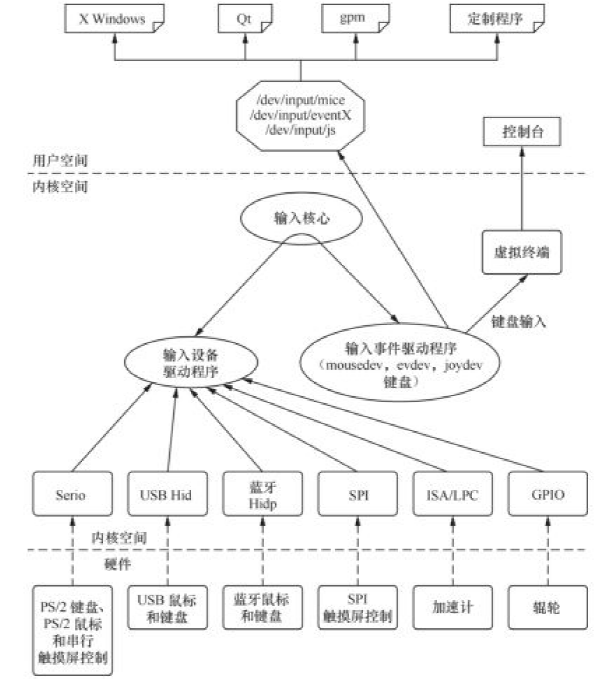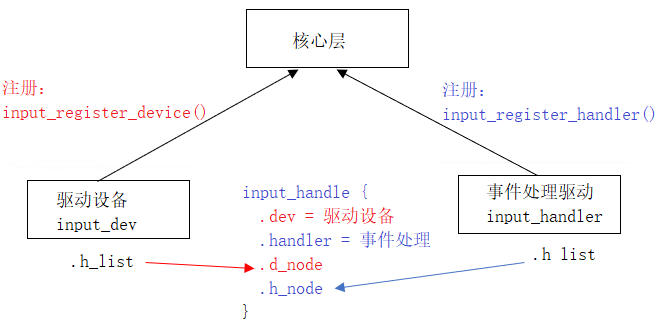前面几章我们写的按键驱动程序虽然已经足够完善,但是这个驱动只有知道/dev/key设备节点和write()格式的人才能使用,不具有适应性
故本节引入标准的输入子系统,来编写通用的输入类设备。输入子系统是对所有的标准输入类设备的统一的管理系统,使用这个模型可以跨平台的处理所有的输入类设备
一、输入子系统分层
输入子系统将一个输入设备的输入过程分成了设备驱动(input device driver)和事件驱动(input event driver)两层。设备驱动负责从底层硬件采集数据,事件驱动负责给用户程序提供接口。通过分层设计,将不同的设备统一到几种驱动接口上。同一种事件驱动可以用来处理多个同类设备;同一个设备也可以和多种事件驱动相衔接。而事件驱动和设备驱动则由输入核心层进行连接,匹配。分层结构如下图:

输入子系统核心层定义在drivers/input/input.c中
由于输入子系统也是字符设备驱动程序,因此它一定也会有创建类、注册字符设备的过程,而且会有file_operations等结构体,我们可以从此进行分析
二、input.c分析
在input_init()函数中所做的和按键驱动程序中所做的大致相同,如创建类、注册名为input的字符设备
static int __init input_init(void) { ... err = class_register(&input_class); ... err = register_chrdev(INPUT_MAJOR, "input", &input_fops); ... }
其file_operations结构体定义如下:
static const struct file_operations input_fops = { .owner = THIS_MODULE, .open = input_open_file, .llseek = noop_llseek, };
当我们应用程序open()时,会调用file_operations input_fops对应的open()函数
static int input_open_file(struct inode *inode, struct file *file) { ... handler = input_table[iminor(inode) >> 5]; if (handler) new_fops = fops_get(handler->fops); ... old_fops = file->f_op; file->f_op = new_fops; err = new_fops->open(inode, file); ... }
由上述代码可知:
1. input_table[]根据次设备号存储handler
2. open()函数使用新的fops(设备驱动中的fops)代替了旧的fops,这个操作也就解释了为什么file_operations结构体中没有读写函数
3. open()函数在替换之后,调用了新的fops的open()函数
handler是我们之前没有分析的,它定义为:
static struct input_handler *input_table[8];
至于数组大小为什么是8,这是因为目前常用的handler只有三种:evdev,mousedev,joydev。而且evdev是通用的handler,定义8个应该够用了
handler结构体定义为:
/** * struct input_handler - implements one of interfaces for input devices * ... */ struct input_handler { void *private; void (*event)(struct input_handle *handle, unsigned int type, unsigned int code, int value); bool (*filter)(struct input_handle *handle, unsigned int type, unsigned int code, int value); bool (*match)(struct input_handler *handler, struct input_dev *dev); int (*connect)(struct input_handler *handler, struct input_dev *dev, const struct input_device_id *id); void (*disconnect)(struct input_handle *handle); void (*start)(struct input_handle *handle); const struct file_operations *fops; int minor; const char *name; const struct input_device_id *id_table; struct list_head h_list; struct list_head node; };
根据注释信息,handler应该就是输入事件驱动程序的结构体
在input_handler结构体中使用了input_handle结构体,其定义如下:
/** * struct input_handle - links input device with an input handler * ... */ struct input_handle { void *private; int open; const char *name; struct input_dev *dev; struct input_handler *handler; struct list_head d_node; struct list_head h_node; };
根据注释信息,input_handle用于连接input_dev和input_handler,三者关系在下面分析
分析完了input.c文件,我们来一一分析input_handler、input_handle以及两者的连接过程
三、input_dev
input_dev使用方法遵循:分配、设置、注册
分配:
struct input_dev *input_allocate_device(void)
设置(首先设置事件类,然后设置具体事件):
void input_set_capability(struct input_dev *dev, unsigned int type, unsigned int code) { switch (type) { case EV_KEY: // 按键事件类,可指定按键如KEY_1、KEY_Q、KEY_ENTER等 __set_bit(code, dev->keybit); break; case EV_REL: // 相对位移事件类,可指定相对位移如REL_X、REL_Y等 __set_bit(code, dev->relbit); break; case EV_ABS: // 绝对位移事件类,可指定绝对位移如ABS_X、ABS_Y等 __set_bit(code, dev->absbit); break; ... } __set_bit(type, dev->evbit); }
注册:
int input_register_device(struct input_dev *dev) { ... /* 通用的同步事件 */ __set_bit(EV_SYN, dev->evbit); ... /* 注册的设备名字为input0, 1, 2, ... */ dev_set_name(&dev->dev, "input%ld", (unsigned long) atomic_inc_return(&input_no) - 1); /* 添加device */ error = device_add(&dev->dev); ... /* 把dev结构放到链表里面 */ list_add_tail(&dev->node, &input_dev_list); /* 对每一个input_handler都调用input_attach_handler()函数 */ list_for_each_entry(handler, &input_handler_list, node) /* 匹配dev和handler */ input_attach_handler(dev, handler); ... }
其中的input_attach_handler(dev, handler);对应input_handle,因为之前说过input_handle用于连接input_dev和input_handler
在注册完成后,若input_dev获得数据,需要向核心层上报事件,上报事件使用如下函数:
// 上报事件 void input_event(struct input_dev *dev, unsigned int type, unsigned int code, int value) // 上报绝对坐标 void input_report_abs(struct input_dev *dev, unsigned int code, int value) // 上报相对坐标 void input_report_rel(struct input_dev *dev, unsigned int code, int value) // 上报键值 void input_report_key(struct input_dev *dev, unsigned int code, int value) // 上报同步事件 void input_sync(struct input_dev *dev)
代码中后四个函数均使用input_event()函数实现,input_event()函数调用过程如下:
input_event() -> input_handle_event() -> input_pass_event() -> handler->event(handle, type, code, value);
上报事件最终会调用handler->event()函数
之前说过evdev是通用的handler,在此我便以/drivers/input/evdev.c进行分析
evdev_read()会进行休眠,evdev_event()在上报事件被调用后会唤醒休眠进程,从而完成read()操作
注销:
// 注销 void input_unregister_device(struct input_dev *dev) // 释放 void input_free_device(struct input_dev *dev)
四、input_handler
注册:
int input_register_handler(struct input_handler *handler) { ... INIT_LIST_HEAD(&handler->h_list); /* 设置input_table */ if (handler->fops != NULL) { if (input_table[handler->minor >> 5]) { retval = -EBUSY; goto out; } input_table[handler->minor >> 5] = handler; } /* 把handler放入input_handler_list */ list_add_tail(&handler->node, &input_handler_list); /* 对每一个dev调用input_attach_handler匹配handler */ list_for_each_entry(dev, &input_dev_list, node) input_attach_handler(dev, handler); ... }
注销:
void input_unregister_handler(struct input_handler *handler)
五、input_dev和input_handler的连接过程
两者匹配使用的是input_attach_handler()函数:
static int input_attach_handler(struct input_dev *dev, struct input_handler *handler) { ... id = input_match_device(handler, dev); ... error = handler->connect(handler, dev, id); ... }
input_match_device()函数:
static const struct input_device_id *input_match_device(struct input_handler *handler, struct input_dev *dev) { for (id = handler->id_table; id->flags || id->driver_info; id++) { // 默认的匹配过程,使用handler->id_table和dev->id进行匹配 if (!handler->match || handler->match(handler, dev)) return id; } }
在代码中,匹配成功退出调用handler的connect()函数,否则调用handler的match()函数
在此还是以evdev为例,其连接函数为evdev_connect()定义如下:
static int evdev_connect(struct input_handler *handler, struct input_dev *dev, const struct input_device_id *id) { ... /* 分配evdev */ evdev = kzalloc(sizeof(struct evdev), GFP_KERNEL); ... /* 设置handle */ evdev->handle.dev = input_get_device(dev); evdev->handle.name = dev_name(&evdev->dev); evdev->handle.handler = handler; evdev->handle.private = evdev; ... /* 注册handle */ error = input_register_handle(&evdev->handle); error = evdev_install_chrdev(evdev); error = device_add(&evdev->dev); ... }
input_dev、input_handler和input_handle三者关系如下:

六、总结
1. input_init()初始化输入子系统
1.1 调用register_chrdev(13, "input", &input_fops);
2. open()输入子系统文件:int input_open_file()
2.1 替换替换file_oprations
2.2 执行new_fops->open()函数
3. 注册input_handler:input_register_handler()
3.1 添加handler到input_table[]数组
3.2 添加handler到input_handler_list链表
3.3 调用input_attach_handler()
4. 注册input_dev:input_register_device()
4.1 添加dev到input_dev链表
4.2 调用input_attach_handler()
5. 匹配:input_attach_handler()
5.1 匹配dev->id和handler->id_table
5.2 成功,调用input_handler->connect()
6. 连接:input_handler->connect()
6.1 创建input_handle,三者连接
7. event发生(如按键中断),在中断函数中上报事件:input_event()
7.1 调用input_handler->event()